MSI readies 10.1-inch tablets for Android and Windows
Dec 13, 2010 — by LinuxDevices Staff — from the LinuxDevices Archive — 2 viewsMSI says it will announce a 10.1-inch tablet that runs Android on an Nvidia Tegra 2 processor at next month's Consumer Electronics Show (CES). At CES, MSI will also announce a similar Windows 7-based tablet touted as one of the first devices using Intel's “Oak Trail” Atom — yet battery life and performance improvements over current Atoms will be “not extremely significant,” an MSI official reportedly told Engadget.
A brief Dec. 13 announcement on MSI's website says that the company will show off two "newest-generation" WindPads at CES, one running Windows and one running Android. Both "chic" machines — referred to as the U100 and U110 when they were first mooted at the Computex show in June, though those names weren't repeated today — will include Wi-Fi, ambient light sensors, andaccelerometers, the release adds.
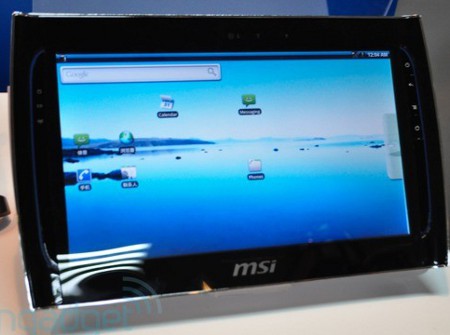
MSI's Android-based WindPad U110, as shown at Computex last June
Source: Engadget
According to a posting by Engadget's Joanna Stern, however, both tablets will include 10.1-inch screens. The Android model will have features similar to those of the Windows model, but will have a different processor and be thinner, says the story. The Windows version is said to be less than one inch thick.
The Android-based device will use an ARM Cortex-A9 based, dual-core Tegra 2 from Nvidia, writes Stern. The tablet's 10.1-inch, multitouch touchscreen will offer 1280 x 800-resolution, says the story. Mini-HDMI and mini-USB ports are said to be available, as well as an SD card slot.
MSI is still uncertain as to which version of Android will be offered, says the story. If Android 3.0 ("Honeycomb"), which is said to be optimized for tablets, is available by the expected February/March ship date, then Honeycomb it will be. Otherwise, it will initially run Android 2.3 ("Gingerbread").
WindPad U100: Only minor power savings from Oak Trail?
The Windows 7-based tablet, meanwhile, "will be one of the first Intel Atom Oak Trail-powered devices out there," writes Engadget's Stern. Oak Trail has already been hailed as a savior by those who hope it will enable x86-based, Windows 7-compatible tablets to match the battery life of their ARM-based competitors. Yet, Stern quotes MSI Director of North American Sales Andy Tung as saying, battery life and performance improvements will be "not extremely significant."
Presumably, Intel would beg to differ. Last week, at a Barclay's Capital 2010 Global Technology Conference, it promised that the Atom — in both Oak Trail and "Moorestown" versions — would form the basis of 35 different tablet computers in 2011.
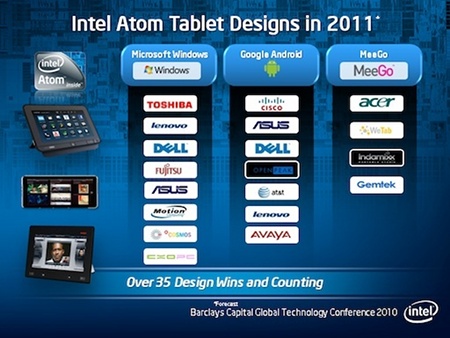
Intel-powered tablets for 2011
Source: Intel via CNet
(Click to enlarge)
A slide above, reproduced by CNet's Brooke Crothers, made no mention of MSI, but did promise new Windows-powered tablets — presumably all using Oak Trail — from Asus, Dell, ExoPC, Fujitsu, Lenovo, Motion Computing, Ocosmos, and Toshiba. It's said Android tablets will be produced by Asus, AT&T, Avaya, Cisco, Dell, Lenovo, and OpenPeak; MeeGo designs, meanwhile, are promised from Acer, Gemtek, WeTab, and Indamixx.
Intel announced "Oak Trail" at the beginning of June, touting it as an Atom platform "optimized for tablets and sleeker netbook form factors due to its reduction in power consumption and thermals." The platform includes a "Lincroft" SoC, a "Langwell" I/O controller, plus some additions (below) code-named "Whitney Point."
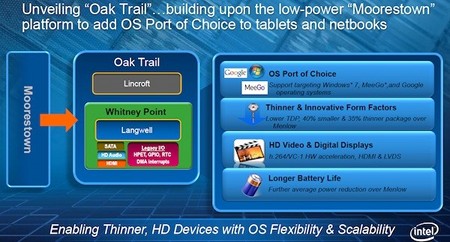
Intel's Oak Trail platform is a superset of Moorestown
(Click to enlarge)
Lincroft — formally known as the Atom Z6xx (below left) — and Langwell are also parts of Intel's long-awaited Moorestown platform, which made its debut in May. Moorestown was announced with support for three flavors of Linux (Android, Moblin 2.1, and MeeGo) but nary a mention of Windows.
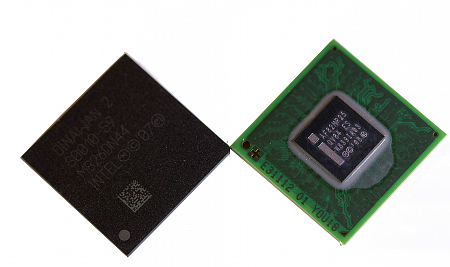
Intel's Z6xx SoC (left) and Platform Controller Hub MP20 (right)
(Click to enlarge)
As it turned out, the Langwell (Platform Controller Hub MP20) chip (above right) gives Moorestown high-speed USB and USB On-The-Go capabilities, cryptographic acceleration (AES, DERS, 3DES, RSA, ECC, SHA-1/2, DRM), and a 24-bit audio DSP, according to Intel. But the Whitney Point superset is what will allow Oak Trail to run Windows 7, since it adds SATA, HD Audio, HDMI, and a variety of legacy I/O (below).
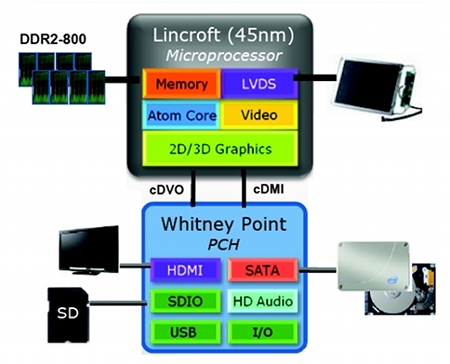
Intel's Oak Trail
(Click to enlarge)
The added functionality described above will increase the Oak Trail chipset's size and power consumption compared to Moorestown. Without providing specific information on packaging details or TDPs — at least as far as we're aware — Intel has promised that Oak Trail will be 40 percent smaller, 35 percent thinner, and have lower power consumption than its first-generation Z5xx Atom.
Further information
Further information on Intel's Atom Z6xx processor may be found on the company's website, here, and, in PDF format, here.
This article was originally published on LinuxDevices.com and has been donated to the open source community by QuinStreet Inc. Please visit LinuxToday.com for up-to-date news and articles about Linux and open source.